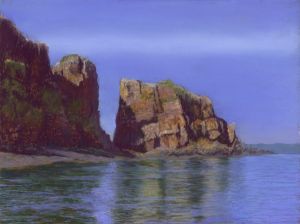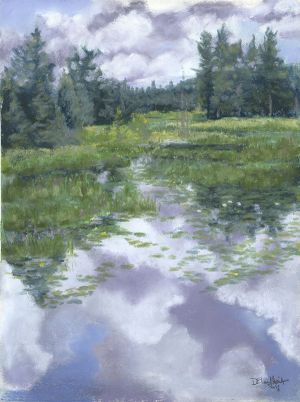Diane E. Leifheit
dianeleifheit.com
There are a couple of thousand pastels in my studio. I usually take around 300 with me when I paint plein air, outdoors. This smaller selection compels me to understand the color I am looking at and then incorporate with some color theories that have crept into my work. The end result is more intuitive than structured. I think, if it is a really green scene what will make it pop? How does light work? And then there is that point of, where is that color?
There is a joy and peace I feel when working outside. The air is a constant shifting companion. Light moves inevitably to reveal new shadows. The commitment to the scene actually is about 3 to 4 hours and the result is about the entirety of that time, not the blink of the camera shutter, but the blinks of 4 hours of my own eye.
History happens over a period of time. Natures history is constantly evolving. The plein air painter is
an historian, capturing a time - be it a barn, or the movement of light, or a coming storm, or flowers temporary presence. Eyes wide open, I work to get that short period onto the board so it can last just a bit longer.
Bio
Diane Leifheit has been painting plein air in pastels for over 20 years beginning with local events and participating in regional festivals, winning second place in Parrsboro Plein Air Internation Festival in 2020.
As a pastel painter, color is what grabs Diane Leifheit. Her home base, the Adirondack Mountains of New York, contains the whole spectrum of color from the blue that is a shadow in a snowbank, to the myriad greens of summer, to the riot of autumn leaves.
Leifheit’s medium of pastel allows her to construct a close interpretation of a particular landscape, but also exhibit the freedom to capture a mood in the work like misty mornings, swirling snowstorms or the atmosphere of a hot, humid day.
Most recently she was painting as far away as the Asturias Mountains in Spain and as close to home as Keeseville, NY and her own back yard. A few years ago she spent a year making one-foot-square pastel portraits of people who live, work and visit in Saranac Lake. The final exhibit in the Saranac Lake Free Library had 185 people looking right back at the viewer in the Thomas Cantwell Community Room where all the portraits were hung.
She is a passionate advocate for the medium of pastel. She will adamantly answer the question: What is pastel? Pastel is pure pigment, the same as in tubes of oil paints and watercolor. It is made into sticks and applied to the surface of the paper in as many varieties as a paintbrush applies oil or watercolor only it is direct from hand to paper.
How well does it hold up under time? One has only to look at the works of Degas, Lautrec, and even da Vinci to find the answer. The color and vibrancy of the Degas ballet dancers is still as brilliant as it was when he painted them in the late 1800s. It is actually the paper that has changed. Now, in this day and age, pastel painters have a distinct advantage in that paper for pastel is made to last, it is archival, made bleach free. Further, glass, the primary protection for a work made of pastel, is available crystal clear. You CAN NOT SEE IT. Diane uses this museum-quality glass to allow her work to be seen without the glare of window glass.
Diane says, “Pastel will keep its color. Unlike an oil painting, it will not suffer from atmospheric changes in the home, i.e. wood smoke, kitchen smoke. Glass is cleaned when it needs to be and the work retains its beauty.”


